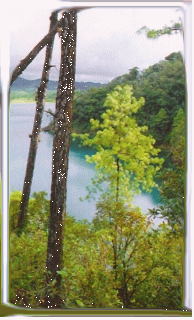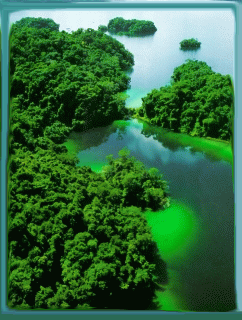 Famous for the colors of their waters, which are due to several factors, such as the type of soil of its bottom, the
vegetation and the refraction of the light. The visit is completed by two roads; the first
one, paved and takes you to the area of the national park, where you can find the
emerald lakes, La Encantada, Bosque Azul, Ensueno, and Agua Tinta, surrounded by
pine forests. There are also several existing services and the possibility of making some
excursions towards San Rafael, a natural arch, under whose rapid waters of a stream,
disappear suddenly into the sub-soil, and various caverns. The other road, of dirt, takes
you to the Montebello lakes Canada, Pojoj, Tziscao and Dos Laguanas amongst others.
Tziscao is the largest of the visitable lakes and it is nearly on the Guatemala border. In
this zone, the descent to the lower lands of the West begins, and this is noticed in the
slow change of Vegetation and climate.
Famous for the colors of their waters, which are due to several factors, such as the type of soil of its bottom, the
vegetation and the refraction of the light. The visit is completed by two roads; the first
one, paved and takes you to the area of the national park, where you can find the
emerald lakes, La Encantada, Bosque Azul, Ensueno, and Agua Tinta, surrounded by
pine forests. There are also several existing services and the possibility of making some
excursions towards San Rafael, a natural arch, under whose rapid waters of a stream,
disappear suddenly into the sub-soil, and various caverns. The other road, of dirt, takes
you to the Montebello lakes Canada, Pojoj, Tziscao and Dos Laguanas amongst others.
Tziscao is the largest of the visitable lakes and it is nearly on the Guatemala border. In
this zone, the descent to the lower lands of the West begins, and this is noticed in the
slow change of Vegetation and climate. The dirt road continues to the Lacandon
jungle, which sometime in the future, will offer
the access to splendid natural beauty areas,
which now, are restricted to the adventurous
tourist. These are the Santo Domingo river
waterfalls and lake Miramar, the largest natural
body of water in the state, and Espejo Sagrado
(sacred mirror), where in one of its islands, the former Lacandons established
their fort and resisted for years the attempts of conquest made by the Spaniards.
The dirt road continues to the Lacandon
jungle, which sometime in the future, will offer
the access to splendid natural beauty areas,
which now, are restricted to the adventurous
tourist. These are the Santo Domingo river
waterfalls and lake Miramar, the largest natural
body of water in the state, and Espejo Sagrado
(sacred mirror), where in one of its islands, the former Lacandons established
their fort and resisted for years the attempts of conquest made by the Spaniards.Once again, back to the main highway, you reach Trinitaria, a town officially known during the colonial period as La Santisima Trinidad de Zapaluta, and at that time dependant on the Dominicans of Comitan. According to colonial documents, its first inhabitants were of the Coxoh tongue. Its main church, of the colonial era, and who’s best element is its facade, is done in great primitiveness. You can appreciate a relief that represents a person, dressed in XVII century clothing, carrying a flag. In the vicinity of the Trinitaria it is possible to make speleological excursions.